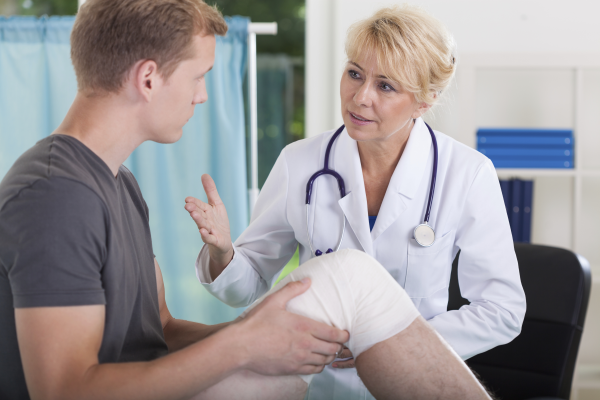
Shoulder pain is the second most common type of pain reported by patients in the United States. The rotator cuff is a complicated structure consisting of four muscle groups that attach to the long bone that connects the shoulder to the elbow.
The muscles and their functions are as follows:
Supraspinatus – Holds the humerous in place and keeps upper arm stable. Also helps with lifting.
Infraspinatus – Main muscle that controls rotation and extension.
Teres Minor – The slim, narrow muscle in the rotator cuff; it assists with rotating the arm away from the body.
Subscapularis – Holds the upper arm bone to the shoulder blade and helps with rotation, holding the arm straight and out and lowering it
Injuries causing pain are common and these injuries usually fall into the following three categories:
Rotator cuff tear – often the result of the wear and tear of daily use.
Tendinitis – an inflammation or irritation of the tendon that attaches to the bone.
Bursitis – irritation of bursa (a small sac filled with fluid that protects the rotator cuff).
Tendinitis and bursitis can get better with nonsurgical treatment.
However, rotator cuff tears often require surgery if physical therapy and medications do not help.
Unfortunately, traditional rotator cuff repair procedures involve suturing tendon to bone and result in long rehabilitation, significant lifestyle changes, and variable outcomes. Which is why many people choose to forego surgery until pain is severe and mobility is significantly impaired. The catch 22 is that as rotator cuff disease progresses, it becomes increasingly difficult to repair.
However, there is a new approach called The Rotation Medical Rotator Cuff System that includes a collagen based bio-inductive implant about the size of a postage stamp. The implant is placed arthroscopically through a small incision over the location of the rotator cuff tendon that is injured. It is secured with small staples. The bio-inductive implant dissolves slowly during the healing process. As it dissolves, it induces growth of new tendon-like tissue, resulting in thicker tendons and replacement of tissue defects.
This technology can be used in earlier stages of rotator cuff disease to slow progression. It can also be used in conjunction with traditional repair procedures to improve tendon biology and decrease the chances of re-tearing the rotator cuff tendon.
The advantages are shorter rehabilitation, faster recovery, potential to prevent or slow down disease progression, and decreased risk of developing a second degenerative tear.
Brachial plexus injuries are among the most devastating injuries, causing significant loss of function and the ability to perform tasks of daily living and in the workplace. They often occur as a result of motorcycle accidents, industrial trauma, or a heavy fall with stretching of the neck.
Early diagnosis and treatment makes a huge difference in eventual outcome.
The brachial plexus is a complex group of nerves that come from the spinal cord in the neck and travel down the arm. These nerves control the muscles of the shoulder, elbow, wrist and hand, and provides feeling in the arms.
These nerves can be damaged by stretching, pressure or cutting. Stretching can occur when the head and neck are forced away from the shoulder, such as during a car accident or a fall off a ladder at work. If the force is severe enough, the nerves can tear out of the spinal cord in the neck. Pressure could occur from the crushing of the brachial plexus between the collarbone and first rib, which can happen during a fracture or dislocation. Swelling in this area from excessive bleeding or injured soft tissues can also cause an injury.
Minor brachial plexus injuries usually completely heal in several weeks, and other injuries are severe enough that they could cause permanent residuals such a loss of function and chronic pain. Early intervention and recent advances in microsurgical reconstruction have greatly improved outcomes.
The more severe injuries or those not caught right away may require reconstructive surgery. Nerve reconstructive surgery is ideally performed within the first 3-6 months after acute injury to permit optimal recovery, allowing time for the regenerating nerves to connect with paralyzed muscles before dense scarring develops. In injuries that occurred more than six months ago, new techniques have enabled surgeons to transfer working muscles with their blood and nerve supply from distant parts of the body, enabling lost elbow flexion and shoulder motion to return.
However, the recovery process is slow –measured in months and years rather than weeks and months. Muscle takes between 6-12 months to recover and then work toward the return of strength and mobility needs to be progressive. State-of-the-art techniques like electric stimulation, biofeedback and pool therapy may be employed to help with the recovery process.
Most brachial plexus injuries are extremely complex because of the myriad of nerves which control function and feeling in the arm. The outcome is generally dependent upon:
Looking at medical developments throughout the last three decades, there have been significant developments in the management of these injuries, which include a better understanding of the anatomy, advances in diagnostic modalities, incorporation of intra-operative nerve stimulation techniques and more liberal use of nerve grafts. Additionally, current microsurgical techniques have resulted in increased functionality of the upper plexus injuries. As research continues, we can expect to see less pain and disability associated with brachial plexus injuries.
Carpal tunnel syndrome (CTS), the most common entrapment neuropathy, is caused by chronic compression of the median nerve as it enters the carpal tunnel. In fact, it is thought that between 3%-6% of US adults have or will develop CTS. It normally develops between the ages of 45-64 years and the prevalence increases with age. It is more common in women than men. Carpal Tunnel Syndrome has been around for a long time; reports of CTS date back to the 1800’s.
Interestingly, after all this time there is still no consensus for a treatment plan for mild to moderate CTS. A 2007 Cochrane review found treating CTS with corticosteroid injections appears to have an unknown affect and effects appear to be temporary with no benefit beyond one month. This study also found two injections of corticosteroids did not provide any additional benefit over one injection. More recently research has indicated that the benefit may last up to 10 weeks, some studies showed up to one year, with less chance of surgical intervention at one year. The problem in studying CTS is it has a tendency to have spontaneous remissions, which may also be partially responsible for a high 20%-34% “Placebo Effect.” The Placebo Effect is a beneficial effect produced by a fake drug or treatment.
A new procedure using ultrasound-guided perineural injection of 5% dextrose (D5W) showed a significant reduction in pain and disability and improved electrophysiological responses. The procedure is still in the testing stages, but could prove to be a much more cost-effective approach to treating CTS. The minimally invasive injections can be performed in a doctor’s office resulting in virtually no recovery period, and a much quicker return to work and other activities of daily living.
Source: https://www.mayoclinicproceedings.org/article/S0025-6196(17)30484-6/fulltext
A study was conducted to find out the prevalence and risk factors of a rotator cuff tear in the general population. The purpose was to clarify the true occurrence of rotator cuff tears regardless of the presence or absence of symptoms.
Study participants consisted of 683 people; 229 males and 454 females with a mean age of 57.9 years (age range was 22-87). Background factors were examined, physical examinations and ultrasonographic examinations on both shoulders.
Interestingly, 20.7% of the study participants had a rotator cuff tear and the frequency increased with age. 36% had a rotator cuff tear with symptoms and 16.9% had a rotator cuff tear but were asymptomatic.
In conclusion, 20.7% of 1,366 shoulders had full thickness rotator cuff tears in the general population. The risk factors included a history of trauma, dominant arm and age.
The subacromial bursa is a small fluid filled sac located at the top, outer aspect of the shoulder designed to reduce friction between the acromion and the tendon of the supraspinatus muscle. While elevating the arm, rotating the shoulder, lifting, pushing, pulling or lying on the shoulder forces are placed on the subacromial bursa. This can also occur with a direct impact or fall onto the point of the shoulder. Irritation and/or inflammation of the bursa can occur over time with repetitious movements or suddenly with a direct blow to the point of the shoulder or a fall onto the shoulder.
Symptoms include pain at the top, front, back or outer aspect of the shoulder, which can sometimes radiate into the upper arm as far as the elbow. Less severe cases may experience an ache or stiffness in the shoulder which increases with rest following activities that placed strain on the bursa. However, as the condition progresses symptoms may increase during the activity or sport.
Although the condition can be diagnosed through a thorough subjective and objective physical examination, an ultrasound is usually used to confirm the diagnosis. Further diagnostics such as x-ray, CT or MRI can assist in the diagnosis of other conditions which may be present and assess the severity of the condition.
Generally, Subacromial Bursitis can be treated conservatively beginning with rest to the shoulder and diligently performing exercises. Physical therapy using ultrasound and cryotherapy to reduce inflammation is also helpful. If that didn’t provide adequate pain relief, then steroid injections could be tried. Surgery is a “last resort” type of care in the form of an arthroscope to visualize and repair any damaged structures.
Subacromial bursitis often occurs in conjunction with other shoulder conditions such as rotator cuff tear, tendinopathy, shoulder impingement or shoulder instability. These are usually of slow onset because the result of repetitive activities at work, but subacromial bursitis can also come about acutely, for example as the result from a direct blow to the shoulder or a fall on the shoulder.
These types of injuries are slow to heal and for that reason can result in high treatment costs and increased employee missed time from work. Often whether or not the claimant heals completely or at all is subjective and the success of treatment falls strongly on the claimant’s compliance. This makes surveillance a great option in cases of high suspicion because if you catch your guy in the middle of 18 holes with no apparent shoulder problems, then you really have something!
 |
|
Chronic low back pain (CLBP) of a minimum three months duration is the second leading cause of disability worldwide; as such it represents a major welfare and economic problem. In the last 10 years, the incidence of CLBP has increased by more than 100% and continues to increase dramatically in the aging population. It is responsible for more global disability than any other health condition. So, whether you are processing worker’s compensation or personal injury claims, low back pain is a condition to be reckoned with.
A back injury in an already degenerating spine can create CLBP. How? Healthy disks have a gel-like substance inside of them that acts as a “shock-absorber,” but as disks degenerate, they shrink, making them less able to buffer against motion. As disks collapse, they begin to compress the spinal nerves that run through them. Additionally, when gel leaks out of a disk (herniation), it results in bulges that can compress nerves or the spinal cord itself.
Recent research has shown that people with disk degeneration have lower levels of a protein called SPARC (secreted protein acidic and cysteine rich). This protein regulates cell growth and binds calcium, and is responsible for several biological processes, namely bone development. It is believed that less SPARC results in accelerated rates of disk degeneration along with low back pain and radiating leg pain. Mice lacking SPARC had an increased number of nerve fibers that were supplying disks and areas around disks which could explain how disk degeneration causes back pain. Degenerating disks have been found to have high levels of NGF (nerve growth factor), which attracts pain-sensing fibers to the area, which increases the subject’s sensation of pain.
But, the most troubling discovery is that over time, chronic low back pain leads to changes in the dorsolateral prefrontal cortex (DLPFC) of the brain. This area of the brain is involved in higher order processes such as conscious decision making, reasoning, working memory, inhibition, as well as outcome prediction.
The good news is that recent test subjects who positively responded to treatment had a reversal of changes to the brain. Research is continuously providing new information concerning chronic low back pain. In fact, there are drug therapies designed to block NGF that are currently in clinical trials, and if proven successful will be a brand new way of treating pain not only for the back but other areas of the body as well.
For more detailed information go to: http://relief.news/deciphering-chronic-low-back-pain/ .
Thank you to our guest blogger, J. Jay Goodman, MD, General and Vascular Surgery. It is highly unlikely that the development of an abdominal wall hernia can be attributable to a single strenuous event. A specific type of abdominal wall hernia referred to as an epigastric hernia (fatty hernia of the linea alba) is defined as a fascial defect of the midline and represents a congenital defect in the fascia between the rectus abdominal musculature. These hernias must lay in the midline between the lower edge of the sternum (xiphoid) and the umbilicus. An umbilical hernia is a separate type of anatomic defect.
The linea alba is embryologically formed by the midline junction of the rectus abdominis sheaths. Epigastric hernias begin as small protrusions of preperitoneal lipomas. An epigastric hernia tends to have small defects (less than 2.0cm) and are difficult to palpate in an obese individual. The hernia can appear spontaneously, and many are asymptomatic. Pain may develop from entrapment of preperitoneal fat or the omentum.
Work activities do not affect the onset or progression of epigastric hernias. If preperitoneal fat or intraabdominal tissue enter these small defects, the pre-existing anatomic pathology may manifest itself. If the hernia strangulates during work activities and emergency surgery is needed, one should relate the emergency need for surgery to the work activity. The work activity does not cause the hernia defect and does not accelerate the deterioration of the hernia.
Once an epigastric has been identified regardless of symptoms, it should be repaired surgically so that a complex emergency repair is avoided.
Dr. Goodman is available to do IMEs in the Milwaukee and Fox Valley areas. Contact Medical Systems for more information or to schedule.
Guest Blogger: Dennis Brown, MD
On July 2, 2017, the prestigious “Journal of American Medical Association” (JAMA) published an authoritative medical study regarding radiofrequency denervation (ablation) procedures for chronic low back pain titled "Effect of Radiofrequency Denervation on Pain Intensity Among Patients With Chronic Low Back Pain," which concluded "The findings do not support the use of radiofrequency denervation to treat chronic low back pain from these sources" (facet joints, sacroiliac joints or a combination of facet joints, sacroiliac joints, or intervertebral disks).
It is medically probable radiofrequency denervation is not medically reasonable or necessary for the treatment of chronic low back pain.
Reference: Johan N. S. Juch, MD; Esther T. Maas, PhD; Raymond W. J. G. Ostelo, PT, PhD, et l Effect of Radiofrequency Denervation on Pain Intensity Among Patients With Chronic Low Back Pain The Mint Randomized Clinical Trials, JAMA. 2017;318(1): 68-91.doi:10.1001/jama.2017.7918
 |
|
Lack of support is the most difficult and critical problem to address because it is often a major factor in an ALJ’s decision that an IME report was not credible. Unfortunately, not all doctors agree on what constitutes adequate support. Thus, the cover letter writer may receive an IME report and conclude that the expert did not support her answers sufficiently, but be faced with a headstrong expert who disagrees. Although difficult, this scenario can be overcome.
First, the IME vendor should work with the writer to explain to the expert the importance of citing relevant evidence, professional experience, and medical literature in the report. The IME vendor should be able to explain to the expert that a conclusory answer without any sort of explanation as to how and why the expert reached the conclusion will not pass muster with the “trier of fact” (ALJ). In truth, experts want to write effective, credible reports because they know that good reports generate more business opportunities. Thus, experts will often be receptive to requests to strengthen their conclusions if the evidence and literature supporting their opinion is obvious and available.
Second, the cover letter writer is typically the person who is most familiar with the claim being addressed, which puts the cover letter writer in the best position to point to the hard evidence and literature that supports the expert’s conclusions. While no IME vendor will tell an expert what to write or what evidence to use, the IME vendor should convey the writer’s concerns to the expert. This would include asking the expert to consider specific relevant evidence or literature in their answers. Ultimately what the cover letter writer and the expert consider to be important evidence may differ, but in cases where the expert’s answer is wholly unsupported they are likely to be receptive to requests to clarify or amplify if the cover letter writer can explain why the answer is problematic unless the expert provides additional support.
No IME vendor can guarantee a perfect report. However, we should expect responsive, consistent, and well-supported IME reports. In judging the report, we should not ask whether the report is favorable but instead whether the expert reached a reasonable and well-supported conclusion from the available evidence. If they did not, your IME vendor can and should work with you to repair deficiencies in the report. Ultimately, those requesting IME reports have the right to expect to receive a reasonable and credible report based on the evidence made available to the expert.
Do you have any ideas on how to strengthen the cover letter so these types of problems are minimized?
 |
Inconsistent responses to your questions in IME reports can sometimes be tricky if the responses do not directly contradict one another. However, if an expert offers two opinions that directly contradict one another, you should expect your IME vendor’s quality assurance editors to catch the issue and resolve it before it gets to you. Occasionally, direct contradictions slip past even the most detail-oriented editors (usually due to report length). In such cases, the expert will sometimes correct direct contradictions in their review of the report. Direct contradictions usually result from the expert misspeaking while dictating the report and are easily fixed.
The harder inconsistency issues arise when the expert doesn’t directly contradict themselves, but provides more than one opinion on the same issue and the statements are ambiguous or vague. Often, the ambiguity or vagueness arises between statements in the general impression section of the report and the specific questions section. A somewhat frequent example is when the expert states in the general impression section that the examinee continues to suffer from subjective complaints that, in the absence of evidence to the contrary, relate to the injury or exposure in question. The expert then states the examinee sustained no permanency in answer to a specific question. The expert may see no inconsistency in these answers, but the cover letter writer undoubtedly will. In cases where the doctor is following the AMA Guides, this may not be an issue because the Guides explicitly allow for zero permanent impairment in cases where there is no objective evidence of injury and only subjective complaints. And usually this is what the expert means when stating subjective complaints relate to the accident or exposure but no permanency resulted.
In these more difficult cases, the IME vendor’s Quality Assurance editors should make every effort to pick up on such inconsistencies and go back to the expert to obtain an explanation of their position and provide clarity, but these are more difficult to catch than direct contradictions. In such cases, it is certainly fair to point out the ambiguity to the doctor and to ask for clarification on their opinion.
The expert in our example could clarify their opinion by stating something to the effect of, “While the examinee continues to register subjective complaints, there is no objective evidence of injury or impairment; hence, it is my opinion that the examinee has sustained no permanent impairment/partial disability as a result of the accident in question.”
Have you encountered these types of inconsistencies in IME reports and if so how did you resolve them?
 |
Post-traumatic stress disorder (PTSD) is a condition of persistent mental and emotional distress occurring as a result of injury or severe psychological shock, typically involving disturbance of sleep and constant vivid recall of experience, with dulled responses to others and to the outside world. Symptoms typically include nightmares or flashbacks, avoidance of situations that bring back the trauma, heightened reactivity to stimuli, anxiety or depressed mood. The condition may last months or years, with triggers that can bring back memories of the trauma accompanied by intense emotional and physical reactions. PTSD is fairly common in the US; more than 3 million cases are diagnosed per year.
Of motor vehicle accident survivors, 9% develop PTSD. Research conducted to identify at-risk individuals disclosed the following:
Pre-existing factors for the likelihood of development of post motor vehicle accident PTSD include:
Accident related variables:
Post-accident predictors are:
The difference between MVA-related PTSD is an increased likelihood of being injured or developing chronic pain syndrome. As a result, many people rely on their primary care physicians for treatment and do not seek out psychological treatment for some time. It is important to identify PTSD symptoms early and seek appropriate psychological treatment so symptoms to not become chronic.
Behavior therapy, cognitive therapy and medications have proven effective for treating MVA-related PTSD. It may also be useful for the claimant to work with a chronic pain specialist to help manage the physical pain caused by injury. These treatments can be provided in conjunction with one another.
To learn more about Post Traumatic Stress Disorder in Civil Litigation, register for our complimentary luncheon presentations by Terence Young, PsyD, a Board Certified Neuropsychologist scheduled to take place on October 19th at Rare on the Square in Madison, and October 26th at the Capital Grille in Milwaukee. See our Seminars/Events page for more information and to register. These presentations will offer CLE credit and space is limited, so register today!
 |
IME Reports can be like the houses from the tale of the three little pigs. A house of straw may look good, but will not stand up to scrutiny. Conversely, a house of bricks, despite a sometimes staid appearance, will withstand even the most withering amounts of scrutiny. In determining whether the expert has constructed a house of straw or a house of bricks, the support the expert cites in reaching their conclusion is critical. For example, an expert that concludes a particular condition is degenerative rather than acute and is hence not related to the work injury or accident but does not explain why this is the case has given the reader a house of straw that will easily be blown down. Instead, the expert should explain why the evidence demonstrates that the condition is degenerative rather than acute.
Thus, in the case of a meniscus tear, the conclusion that the condition is not work-related will be more credible if the doctor explains that a complex tear is most likely to be degenerative because the tearing reflects multiple wear points occurring over a long period of time, that the mechanism of injury reflects a degenerative condition because the onset of pain was insidious and not following an acute twisting episode of the knee, and that the medical literature demonstrates that a significant portion of persons in the examinee’s age cohort who are asymptomatic have degenerative meniscus tears.
The same is true for MMI, work restrictions, extent of permanency, and the need for medical treatment: what evidence demonstrates that medical improvement stopped occurring at a specific point in time? What evidence demonstrates the need for work restrictions or lack thereof? What evidence demonstrates the extent of permanency or the need for ongoing treatment? The point being that a conclusion without support is just waiting for the big bad wolf (or one’s opponent – perhaps they are one and the same!) to blow the house down.
What is your technique to assure the experts’ opinions are evidence-based? Do you have any “battle” stories to share?
 |
The context in which an IME report arises is important, but our main question will always be: “How do we determine if the report is good once we finally have it?” At the outset, it must be noted that whether the report is favorable or not is of course significant to the reader, but favorability in and of itself does not reflect the report’s quality. Put simply, reason is indifferent to results. If the report is well-reasoned and well-supported, regardless of the favorability of the opinion, it is a good report.
When evaluating an IME report, consistency matters. Inconsistent reports are not credible and they also make it difficult for the reader to figure out what, if anything, must be conceded on the claim. Opinions should be consistent throughout the report with respect to causation, end of healing/maximum medical improvement, relatedness of and necessity for treatment, and work restrictions, among other things. To maximize the likelihood of receiving a consistent report, the specific questions asked of the expert matter. A report is more likely to be consistent if each issue to be resolved is only asked about once. Asking about causation in more than one question risks getting inconsistent answers. Regardless though, one should expect to receive a report from an expert that is consistent with respect to all of the issues about which the expert is asked. Hence, the general discussion section should have the exact same end of healing date as the answer to the specific question about end of healing. Fortunately, inconsistency is easy to fix since it usually just involves the expert picking one of two positions and applying it uniformly.
Logic is important to IME reports. A report in which the expert’s conclusions do not flow from the evidence will not be deemed credible. It should also be noted that whether a conclusion flows logically from the evidence is not the same as the likelihood that the expert would come to that specific conclusion. A conclusion may flow logically from the evidence despite the reader’s opinion that the expert was more likely to reach a different conclusion. The reader should not be upset if the expert reaches a logically consistent and well-supported conclusion even if it is somewhat unexpected. A favorable conclusion that is not supported by the evidence makes a good result a bad one because the conclusion will not be credible.
In conclusion, consistency and logic are imperative to well-supported opinions that make for a credible IME report. The IME vendor can help in this regard by providing thorough reviews of reports and catching both the obvious and the obscure.
Do you have particular doctors that make problems for logic and consistency? What do you do to fix the problem?
 |
Although there is no cure-all that can make every IME report perfect, some things do make a difference. For example, IME experts are more likely to give more weight to the history that is given closest in time to the injury. Hence, it is vital to take recorded statements as soon as possible after an injury is reported. IME experts are also more likely to be suspicious of an injury’s legitimacy if contradictory histories of injury are given. In addition, evidence of prior problems involving the same body part increases the likelihood that the expert will conclude that the examinee experienced a mere manifestation of a preexisting condition or a temporary aggravation. Diagnostic imaging studies often can be used to predict whether the expert will conclude that the condition is traumatic or preexisting and chronic.
One underappreciated factor in predicting the outcome of a report is mechanism of injury. Often how the examinee claims the injury happened is critically important. We can reliably predict that an orthopedist will find a meniscus tear to be non-industrial if the examinee does not report a twisting mechanism of injury. Also, in cases of significant acute injury and disability, a delay in treatment increases the likelihood that the expert will find that the injury did not occur as alleged and represents the mere manifestation of a preexisting degenerative condition. For example, an expert is more likely to conclude a massive rotator cuff tear has a non-industrial origin if the examinee claims a traumatic episode cause the injury but he nonetheless waited a week to report it because the expert is likely to conclude that a massive acute tear would be so painful and disabling that the examinee could not continue working and would have reported the injury immediately.
Mechanism of injury is important in occupational exposure claims as well. An accurate job description, job video, and physical demands analysis tailored to the examinee can go a long way toward predicting whether the expert will find the work exposure to be a cause of the condition. Finally, the examinee’s personality will have some bearing on the expert’s opinion. Experts tend to be less sympathetic toward hostile and unpleasant persons then friendly and straightforward persons.
What is your technique to substantiate mechanism of injury? Does it work and why?
 |
|
Cognitive biases and personal judgment tends to cloud how we assess problems and outcomes. When evaluating a report, we should be aware of these biases so that we can avoid them and the distorted view they give us. Some common cognitive biases include:
Ambiguity– the tendency to avoid options for which missing information makes probability seem ‘unknown;’
Availability heuristic – overestimating the likelihood of events with greater availability in memory, i.e. events more noteworthy or nearer in time;
Anchoring– the tendency to rely too heavily on one piece of information when making decisions (usually the first information we receive);
Confirmation– the tendency to find, interpret, and look for evidence that confirms one’s preconceptions;
Bayesian conservatism – the tendency to revise one’s beliefs insufficiently when presented with new evidence;
Illusion of control – the tendency to overestimate one’s degree of influence over external events;
Sunk cost fallacy – justifying increased investment in a decision based on cumulative prior investment despite new information suggesting that the decision was probably wrong;
Outcome bias – the tendency to judge a decision based on its eventual outcome rather than on the quality of the decision at the time it was made, i.e. the pro athlete that doesn’t get cut because of a huge signing bonus or guaranteed contract long after it becomes obvious that his performance has deteriorated; and
Subjective validation – the tendency to perceive something as true if a subject’s belief demands it be true (“I think he’s a faker so the report is garbage if it doesn’t confirm my belief that he’s a faker”).
Being aware of and attempting to eliminate our innate biases will make us better judges of reports. For example, the cover letter writer may have had seven previous claims with the examinee all of which were suspicious. This will tend to cause the cover letter writer to be subject to the Anchoring Bias, seeking validation and making him prone to negatively judge any outcome that does not confirm his uncertainties. Failing to eliminate these biases can be damaging to the claim if the injury was witnessed, promptly reported, and is supported by adequate objective medical evidence. In such a case, an unbiased person would consider the conclusion that the examinee’s complaints are related to the work injury to be both reasonable and likely.
What bias are you most “guilty” of and why?